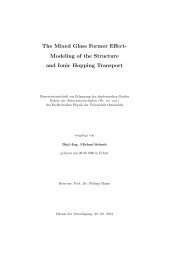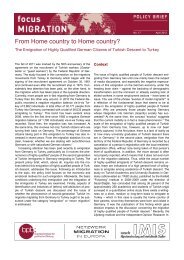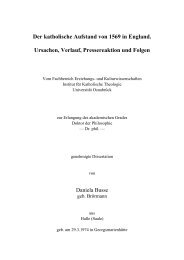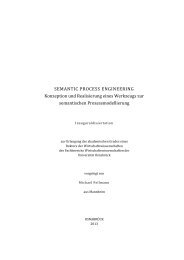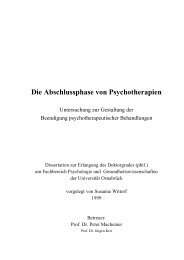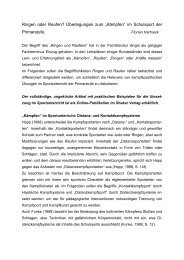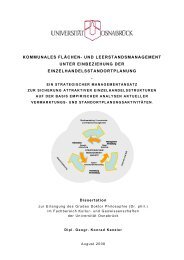334 Literatur ANGERMEYER, M. C. & DIETRICH, S. (2006). Public beliefs about and attitudes towards people with mental illness: A review of population studies. Acta Psychiatrica Scandinavica, 113(3), 163-179. ANGERMEYER, M. C. & KLUSMANN, D. (1988). The causes of functional psychoses as seen by patients and their relatives: I. The patients' point of view. European Archives of Psychiatry & Neurological Sciences, 238(1), 47-54. ANONYMOUS (2007). Why having a mental illness is not like having diabetes. Schizophrenia Bulletin, 33(4), 846-847. ANTONOVSKY, A. (1990). Pathways leading to successful coping and health. In M. ROSENBAUM (Hrsg.), Learned resourcefulness: On coping skills, self-control, and adaptive behavior (S. 31-63). New York, USA: Springer. ARIETI, S. (1973). Anxiety and beyond in schizophrenia and psychotic depression. American Journal of Psychotherapy, 27(3), 338-345. ARON, A. R., SHOHAMY, D., CLARK, J., MYERS, C., GLUCK, M. A. & POLDRACK, R. A. (2004). Human midbrain sensitivity to cognitive feedback and uncertainty during classification learning. Journal of Neurophysiology, 92(2), 1144-1152. ASHBY, F. G. & MADDOX, W. T. (2005). Human category learning. Annual Review of Psychology, 56, 149-178. ATKINS, D. C., BEDICS, J. D., MCGLINCHEY, J. B. & BEAUCHAINE, T. P. (2005). Assessing clinical significance: Does it matter which method we use? Journal of Consulting and Clinical Psychology, 73(5), 982-989. ATKINS, M., BURGESS, A., BOTTOMLEY, C. & RICCIO, M. (1997). Chlorpromazine equivalents: A consensus of opinion for both clinical and research applications. Psychiatric Bulletin, 21(4), 224-226. AXELROD, B. N., GOLDMAN, R. S., HEATON, R. K., CURTISS, G., THOMPSON, L. T., CHELUNE, G. J. & KAY, G. G. (1996). Discriminability of the Wisconsin Card Sorting Test using the standardization sample. Journal of Clinical and Experimental Neuropsychology, 18(3), 338-342. AXELROD, B. N., GOLDMAN, R. S. & WOODARD, J. L. (1992). Interrater reliability in scoring the Wisconsin Card Sorting Test. Clinical Neuropsychologist, 6(2), 143-155. AXELROD, B. N., JIRON, C. C. & HENRY, R. R. (1993). Performance of adults ages 20 to 90 on the abbreviated Wisconsin Card Sorting Test. Clinical Neuropsychologist, 7(2), 205-209. BABINSKI, J. (1914). Contribution à l'étude des troubles mentaux dans l'hémiplégie organique cérébrale (Anosognosie). Revue Neurologique, 27, 845-848. BACKHAUS, K., ERICHSON, B., PLINKE, W. & WEIBER, R. (2006). Multivariate Analysemethoden. Eine anwendungsorientierte Einführung (11. Aufl.). Berlin: Springer. BADDELEY, A. (2003). Working memory: Looking back and looking forward. Nature Reviews Neuroscience, 4(10), 829- 839. BADRE, D. & WAGNER, A. D. (2007). Left ventrolateral prefrontal cortex and the cognitive control of memory. Neuropsychologia, 45(13), 2883-2901. BAKER, R. & HALL, J. N. (1988). REHAB: A new assessment instrument for chronic psychiatric patients. Schizophrenia Bulletin, 14(1), 97-111. BANDURA, A. (1977). Self-efficacy: Toward a unifying theory of behavioral change. Psychological Review, 84(2), 191-215. BARCELÓ, F. (2001). Does the Wisconsin Card Sorting Test measure prefrontal function? Spanish Journal of Psychology, 4(1), 79-100. BARCELÓ, F. & KNIGHT, R. T. (2002). Both random and perspective errors <strong>und</strong>erlie WCST deficits in prefrontal patients. Neuropsychologia, 40(3), 349-356. BARCH, D. M., BERMAN, M. G., ENGLE, R., JONES, J. H., JONIDES, J., MACDONALD III, A., NEE, D. E., REDICK, T. S. & SPONHEIM, S. R. (2009). CNTRICS final task selection: Working memory. Schizophrenia Bulletin, 35(1), 136-152. BARCH, D. M., BRAVER, T. S., CARTER, C. S., ROBBINS, T. W. & POLDRACK, R. A. (2009). CNTRICS final task selection: Executive control. Schizophrenia Bulletin, 35(1), 115-135. BARCH, D. M. & SMITH, E. (2008). The cognitive neuroscience of working memory: Relevance to CNTRICS and schizophrenia. Biological Psychiatry, 64, 11-17. BARD, M. & DYK, R. B. (1956). The psychodynamic significance of beliefs regarding the cause of serious illness. Psychoanalytic Review, 43, 146-162. BARDE, L. H. F. & THOMPSON-SCHILL, S. L. (2002). Models of functional organization of the lateral prefrontal cortex in verbal working memory: Evidence in favor of the process model. Journal of Cognitive Neuroscience, 14(7), 1054- 1063. BARKER, D. A., SHERGILL, S. S., HIGGINSON, I. & ORRELL, M. W. (1996). Patients' views towards care received from psychiatrists. British Journal of Psychiatry, 168(5), 641-646. BASSITT, D. P., NETO, M. R. L., DE CASTRO, C. C. & BUSATTO, G. F. (2007). Insight and regional brain volumes in schizophrenia. European Archives of Psychiatry and Clinical Neuroscience, 257(1), 58-62. BASSO, M. R., BORNSTEIN, R. A. & LANG, J. M. (1999). Practice effects on commonly used measures of executive function across twelve months. Clinical Neuropsychologist, 13(3), 283-292. BASSO, M. R., LOWERY, N., GHORMLEY, C., & BORNSTEIN, R. A. (2001). Practice effects on the Wisconsin Card Sorting Test – 64 card version across 12 months. Clinical Neuropsychologist, 15(4), 471-478. BAUER, A. & VOLLMANN, J. (2002). Einwilligungsfähigkeit bei psychisch Kranken: Eine Übersicht empirischer Untersuchungen. Nervenarzt, 73(10), 1031-1038. BAUER, S., LAMBERT, M. J. & NIELSEN, S. L. (2004). Clinical significance methods: A comparison of statistical techniques. Journal of Personality Assessment, 82(1), 60-70.
335 Literatur BAUMEISTER, R. F., DALE, K. & SOMMER, K. L. (1998). Freudian defense mechanisms and empirical findings in modern social psychology: Reaction formation, projection, displacement, <strong>und</strong>oing, isolation, sublimation, and denial. Journal of Personality, 66(6), 1081-1124. BEAUDUCEL, A. (2001). Problems with parallel analysis in data sets with oblique simple structure. Methods of Psychological Research, 6, 141-157. BECK, A. T. (1967). Cognitive therapy and the emotional disorders. New York: Meridian. BECK, A. T. & RECTOR, N. A. (2002). Delusions: A cognitive perspective. Journal of Cognitive Psychotherapy, 16(4), 455- 468. BECK, A. T. & RECTOR, N. A. (2003). A cognitive model of hallucinations. Cognitive Therapy and Research, 27(1), 19-52. BECK, A. T., BARUCH, E., BALTER, J. M., STEER, R. A. & WARMAN, D. M. (2004). A new instrument for measuring insight: the Beck Cognitive Insight Scale. Schizophrenia Research, 68(2-3), 319-329. BECK-SANDER, A. (1998). Is insight into psychosis meaningful? Journal of Mental Health, 7(1), 25-34. BELL, M. D., GREIG, T. C., KAPLAN, E. & BRYSON, G. (1997). Wisconsin Card Sorting Test dimensions in schizophrenia: Factorial, predictive, and divergent validity. Journal of Clinical and Experimental Neuropsychology, 19(6), 933- 941. BELL, M. D., LYSAKER, P. H., BEAM-GOULET, J. L., MILSTEIN, R. M. & LINDENMAYER, J.-P. (1994). Five-component model of schizophrenia: Assessing the factorial invariance of the Positive and Negative Syndrome Scale. Psychiatry Research, 52(3), 295-303. BELLACK, A. S., MUESER, K. T., MORRISON, R. L., TIERNEY, A. & PODELL, K. (1990). Remediation of cognitive deficits in schizophrenia. American Journal of Psychiatry, 147(12), 650-655. BENGE, J. F., CAROSELLI, J. S. & TEMPLE, R. O. (2007). Wisconsin Card Sorting Test: Factor structure and relationship to productivity and supervision needs following severe traumatic brain injury. Brain Injury, 21(4), 395-400. BENINGER, R. J., WASSERMAN, J., ZANIBBI, K., CHARBONNEAU, D., MANGELS, J., BENINGER, B. V. (2003). Typical and atypical antipsychotic medications differentially affect two nondeclarative memory tasks in schizophrenic patients: A double dissociation. Schizophrenia Research, 61(2-3), 281-292. BENKERT, O., HIPPIUS, H., ANGHELESCU, I., DAVIDS, E., FEHR, C., GRÜNDER, G., HIEMKE, C., LANGE-ASSCHENFELDT, C., MÜLLER, M. J. & SZEGEDI, A. (2005). Kompendium der psychiatrischen Pharmakotherapie (5. Aufl.). Heidelberg: Springer Medizin. BENTALL, R. P. (2003). Madness explained. Psychosis and human nature. London: Penguin. BENTON, A. L., & HAMSHER, K. DES. (1976). Multilingual Aphasia Examination. Manual of instruction. Iowa City: University of Iowa, Department of Neurology. BERG, E. A. (1948). A simple objective technique for measuring flexibility in thinking. Journal of General Psychology, 39, 15-22. BERMAN, K. F., OSTREM, J. L., RANDOLPH, C., GOLD, J., GOLDBERG, T. E., COPPOLA, R., CARSON, R. E., HERSCOVITCH, P. & WEINBERGER, D. R. (1995). Physiological activation of a cortical network during performance of the Wisconsin Card Sorting Test: A positron emission tomography study. Neuropsychologia, 33(8), 1027-1046. BEUTEL, M. (1988). Bewältigungsprozesse bei chronischen Erkrankungen. Weinheim: VCH. BILDER, R. M., REITER, G., BATES, J., LENCZ, T., SZESZKO, P., GOLDMAN, R. S., ROBINSON, D., LIEBERMAN, J. A. & KANE, J. M. (2006). Cognitive development in schizophrenia: Follow-back from the first episode. Journal of Clinical and Experimental Neuropsychology, 28(2), 270-282. BILLINGS, A. G. & MOOS, R. H. (1981). The role of coping responses and social resources in attenuating the stress of life events. Journal of Behavioral Medicine, 4, 139-157. BIRCHWOOD, M. (2003). Pathways to emotional dysfunction in first-episode psychosis. British Journal of Psychiatry, 182(5), 373-375. BIRCHWOOD, M. & CHADWICK, P. (1997). The omnipotence of voices: Testing the validity of cognitive model. Psychological Medicine, 27(6), 1345-1353. BIRCHWOOD, M., IQBAL, Z. & UPTHEGROVE, R. (2005). Psychological pathways to depression in schizophrenia: Studies in acute psychosis, post psychotic depression and auditory hallucinations. European Archives of Psychiatry and Clinical Neuroscience, 255(3), 202-212. BIRCHWOOD, M., MASON, R., MACMILLAN, F. & HEALY, J. (1993). Depression, demoralization and control over psychotic illness: A comparison of depressed and non-depressed patients with a chronic psychosis. Psychological Medicine, 23(2), 387-395. BIRCHWOOD, M., SMITH, J., DRURY, V., HEALY, J., MACMILLAN, F. & SLADE, M. (1994). A self-report insight scale for psychosis: Reliability, validity and sensitivity to change. Acta Psychiatrica Scandinavica, 89(1), 62-67. BIRCHWOOD, M., TROWER, P., BRUNET, K., GILBERT, P., IQBAL, Z. & JACKSON, C. (2007). Social anxiety and the shame of psychosis: A study in first episode psychosis. Behaviour Research and Therapy, 45(5), 1025-1037. BIRD, C. M., PAPADOPOULOU, K., RICCIARDELLI, P., ROSSOR, M. N. & CIPOLOTTI, L. (2004). Monitoring cognitive changes: Psychometric properties of six cognitive tests. British Journal of Clinical Psychology, 43(2), 197-210. BISCHOF-KÖHLER, D. (1998). Zusammenhänge zwischen kognitiver, motivationaler <strong>und</strong> emotionaler Entwicklung in der frühen Kindheit <strong>und</strong> im Vorschulalter. In H. KELLER (Hrsg.), Lehrbuch Entwicklungspsychologie (S. 319-376). Bern: Huber. BLANK, J. (2009). <strong>Krankheitseinsicht</strong> <strong>und</strong> Bewältigung bei Schizophrenie. Unveröffentlichte Diplomarbeit, Universität Osnabrück.
- Seite 1 und 2:
Krankheitseinsicht, dynamisch getes
- Seite 3 und 4:
Danksagung iii Einleitung Es wird Z
- Seite 5 und 6:
v Einleitung 5.2.3.5 Prozessorienti
- Seite 7 und 8:
vii Einleitung 12.1.3 Ergebnisse St
- Seite 9 und 10:
ix Einleitung Tabelle 45. Hauptkomp
- Seite 11 und 12:
Tabelle 1. Verzeichnis der wichtigs
- Seite 13 und 14:
Abstract xiii Einleitung Objective:
- Seite 15 und 16:
15 Einleitung Angesichts der Belieb
- Seite 17 und 18:
17 Einleitung Bewältigungsmodell v
- Seite 19 und 20:
19 Wisconsin Card Sorting Test 2001
- Seite 21 und 22:
21 Wisconsin Card Sorting Test Effe
- Seite 23 und 24:
23 Wisconsin Card Sorting Test Das
- Seite 25 und 26:
Tabelle 2. Exekutive und Arbeitsged
- Seite 27 und 28:
3.3 Durchführung und Kennwerte des
- Seite 29 und 30:
3.4 WCST-Defizite bei Schizophrenie
- Seite 31 und 32:
Tabelle 5. Konzeptuelles Schema zur
- Seite 33 und 34:
3.5.1 Attributidentifikation / Abst
- Seite 35 und 36:
35 Wisconsin Card Sorting Test oder
- Seite 37 und 38:
37 Wisconsin Card Sorting Test elem
- Seite 39 und 40:
39 Wisconsin Card Sorting Test ein
- Seite 41 und 42:
41 Wisconsin Card Sorting Test Fehl
- Seite 43 und 44:
43 Wisconsin Card Sorting Test zus
- Seite 45 und 46:
45 Wisconsin Card Sorting Test Lern
- Seite 47 und 48:
3.5.5 Orientierungsvariablen 47 Wis
- Seite 49 und 50:
49 Wisconsin Card Sorting Test zehn
- Seite 51 und 52:
51 Wisconsin Card Sorting Test Fehl
- Seite 53 und 54:
53 Wisconsin Card Sorting Test mit
- Seite 55 und 56:
55 Wisconsin Card Sorting Test PAOL
- Seite 57 und 58:
Tabelle 6. Übersicht über Studien
- Seite 59 und 60:
3.7.3 Faktorstruktur des WCST 59 Wi
- Seite 61 und 62:
Tabelle 7 (Fortsetzung). (o) (p) (q
- Seite 63 und 64:
3.8.2 Bildung 63 Wisconsin Card Sor
- Seite 65 und 66:
3.9 Der Dynamische WCST in der Schi
- Seite 67 und 68:
67 Wisconsin Card Sorting Test darg
- Seite 69 und 70:
69 Wisconsin Card Sorting Test WIED
- Seite 71 und 72:
71 Wisconsin Card Sorting Test Durc
- Seite 73 und 74:
73 Wisconsin Card Sorting Test 3.9.
- Seite 75 und 76:
75 Wisconsin Card Sorting Test WALL
- Seite 77 und 78:
4. Statistische Modelle der Veränd
- Seite 79 und 80:
79 Reliable Change Index mittleren
- Seite 81 und 82:
81 Reliable Change Index (b) x2 sol
- Seite 83 und 84:
83 Reliable Change Index (3.) regre
- Seite 85 und 86:
85 Reliable Change Index Bei einem
- Seite 87 und 88:
87 Reliable Change Index statistisc
- Seite 89 und 90:
89 Reliable Change Index der Differ
- Seite 91 und 92:
91 Reliable Change Index Patienten
- Seite 93 und 94:
93 Reliable Change Index Tabelle 8.
- Seite 95 und 96:
95 Reliable Change Index WIEDL, WIE
- Seite 97 und 98:
97 Coping und Abwehr (3.) die oftma
- Seite 99 und 100:
Darstellung der wichtigsten tiefenp
- Seite 101 und 102:
101 Coping und Abwehr unterschiedli
- Seite 103 und 104:
103 Coping und Abwehr von Bewältig
- Seite 105 und 106:
105 Coping und Abwehr bedrohliche K
- Seite 107 und 108:
107 Coping und Abwehr das Problem d
- Seite 109 und 110:
5.2.3.6 Antezedenzien von Bewertung
- Seite 111 und 112:
6. Krankheitseinsicht von Menschen
- Seite 113 und 114:
113 Krankheitseinsicht die Bedeutun
- Seite 115 und 116:
115 Krankheitseinsicht Kombination
- Seite 117 und 118:
117 Krankheitseinsicht negative Bew
- Seite 119 und 120:
119 Krankheitseinsicht Während die
- Seite 121 und 122:
121 Krankheitseinsicht WARNER, TAYL
- Seite 123 und 124:
123 Krankheitseinsicht Symptomatik
- Seite 125 und 126:
125 Krankheitseinsicht (z. B. aus d
- Seite 127 und 128:
127 Krankheitseinsicht Diesem Zweck
- Seite 129 und 130:
6.5.2 Krankheitseinsicht: Begriffsk
- Seite 131 und 132:
131 Krankheitseinsicht Der erste be
- Seite 133 und 134:
Tabelle 11. Konfigurationen von Ein
- Seite 135 und 136:
6.5.4.1 Einsichts-Interviews 135 Kr
- Seite 137 und 138:
137 Krankheitseinsicht having sympt
- Seite 139 und 140:
139 Krankheitseinsicht Self-Apprais
- Seite 141 und 142:
141 Krankheitseinsicht chronifizier
- Seite 143 und 144:
143 Krankheitseinsicht have a menta
- Seite 145 und 146:
145 Krankheitseinsicht veröffentli
- Seite 147 und 148:
147 Krankheitseinsicht werden als r
- Seite 149 und 150:
149 Krankheitseinsicht Wichtig wär
- Seite 151 und 152:
151 Krankheitseinsicht Die Befundla
- Seite 153 und 154:
Pfad b Interaktionale Konstruktion
- Seite 155 und 156:
155 Krankheitseinsicht Validierung
- Seite 157 und 158:
6.5.12 Die nosologische Hypothese:
- Seite 159 und 160:
159 Krankheitseinsicht Die Möglich
- Seite 161 und 162:
161 Krankheitseinsicht Exekutivfunk
- Seite 163 und 164:
163 Krankheitseinsicht (z. B. HILL,
- Seite 165 und 166:
165 Krankheitseinsicht Einige Autor
- Seite 167 und 168:
167 Krankheitseinsicht Fehlattribut
- Seite 169 und 170:
6.5.14 Motivationale Hypothesen: Ab
- Seite 171 und 172:
171 Krankheitseinsicht Das RS-Konze
- Seite 173 und 174:
173 Krankheitseinsicht problemzentr
- Seite 175 und 176:
175 Krankheitseinsicht ursprünglic
- Seite 177 und 178:
177 Krankheitseinsicht reduzierter
- Seite 179 und 180:
179 Krankheitseinsicht äußerst kn
- Seite 181 und 182:
Prämorbide Intelligenz Psychose- E
- Seite 183 und 184:
183 Krankheitseinsicht personen, al
- Seite 185 und 186:
6.5.16 Multifaktorielle Einsichts-M
- Seite 187 und 188:
187 Krankheitseinsicht Erkrankungsb
- Seite 189 und 190:
7. Fragestellungen und Hypothesen 1
- Seite 191 und 192:
Hypothese 2.4: Validierung anhand d
- Seite 193 und 194:
Hypothese 3.3: Einsicht und Exekuti
- Seite 195 und 196:
8. Methoden 8.1 Beschreibung der In
- Seite 197 und 198:
197 Methoden Select-by-marker-Analy
- Seite 199 und 200:
199 Methoden eine weitere, eher all
- Seite 201 und 202:
201 Methoden Obwohl ursprünglich l
- Seite 203 und 204:
203 Methoden Tabelle 15 stellt den
- Seite 205 und 206:
205 Ergebnisse Studie 1 Hälfte auc
- Seite 207 und 208:
207 Ergebnisse Studie 1 Tabelle 18.
- Seite 209 und 210:
9.4 Hauptkomponentenanalyse des WCS
- Seite 211 und 212:
10. Ergebnisse Studie 2: 211 Ergebn
- Seite 213 und 214:
213 Ergebnisse Studie 2 postakuten
- Seite 215 und 216:
215 Ergebnisse Studie 2 entspricht
- Seite 217 und 218:
217 Ergebnisse Studie 2 Verteilung
- Seite 219 und 220:
Tabelle 24. Übersicht über berech
- Seite 221 und 222:
Tabelle 26. Zehn WCST-Performanztyp
- Seite 223 und 224:
223 Ergebnisse Studie 2 Zusammenhan
- Seite 225 und 226:
10.6 Unterschiedstests und Konkorda
- Seite 227 und 228:
227 Ergebnisse Studie 2 nach LANDIS
- Seite 229 und 230:
229 Ergebnisse Studie 2 zur Decke,
- Seite 231 und 232:
10.8 Komposition von Metatypen 231
- Seite 233 und 234:
Tabelle 35. Cluster-Varianzen und F
- Seite 235 und 236:
10.8.2 Übereinstimmung von RCI-Typ
- Seite 237 und 238:
Tabelle 39. Kreuztabelle WCSTdyn-Cl
- Seite 239 und 240:
239 Ergebnisse Studie 2 Die dargest
- Seite 241 und 242:
Tabelle 42. Korrekte Sortierungen i
- Seite 243 und 244:
10.9 Soziodemographische und klinis
- Seite 245 und 246:
Tabelle 45. Rotierte Komponentenmat
- Seite 247 und 248:
10.10 Externe Validierung der Metat
- Seite 249 und 250:
249 Ergebnisse Studie 2 Es besteht
- Seite 251 und 252:
Tabelle 51. Lernverläufe der AVLT-
- Seite 253 und 254:
253 Ergebnisse Studie 2 10.10.3 Faz
- Seite 255 und 256:
255 Ergebnisse Studie 2 Angesichts
- Seite 257 und 258:
10.12 Analyse von WCST-Fehlerprofil
- Seite 259 und 260:
259 Ergebnisse Studie 2 ausschließ
- Seite 261 und 262:
261 Ergebnisse Studie 2 Die Fehler-
- Seite 263 und 264:
263 Ergebnisse Studie 3 den Zusamme
- Seite 265 und 266:
265 Ergebnisse Studie 3 übrigen It
- Seite 267 und 268:
267 Ergebnisse Studie 3 Partialkorr
- Seite 269 und 270:
Tabelle 66. Symptombewusstheit, Pos
- Seite 271 und 272:
271 Ergebnisse Studie 3 11.6 Konver
- Seite 273 und 274:
11.8 Aktive und passive Medikations
- Seite 275 und 276:
11.10 Einsicht, Exekutivfunktionen
- Seite 277 und 278:
277 Ergebnisse Studie 3 Offenheit k
- Seite 279 und 280:
279 Ergebnisse Studie 3 52 Patiente
- Seite 281 und 282:
281 Ergebnisse Studie 3 wies einen
- Seite 283 und 284: 283 Ergebnisse Studie 3 Insgesamt k
- Seite 285 und 286: 285 Ergebnisse Studie 3 Das gleiche
- Seite 287 und 288: 287 Ergebnisse Studie 3 G12 = 3,5 (
- Seite 289 und 290: Tabelle 81. Kognition und Symptomat
- Seite 291 und 292: 291 Ergebnisse Studie 3 Aufgrund de
- Seite 293 und 294: 293 Ergebnisse Studie 3 Es ist auff
- Seite 295 und 296: 295 Ergebnisse Studie 3 Im nächste
- Seite 297 und 298: 297 Ergebnisse Studie 3 kognitiv le
- Seite 299 und 300: 299 Diskussion An einer nicht-psych
- Seite 301 und 302: Hypothese Gegenstand Ergebnis 2.1 S
- Seite 303 und 304: 3.5 Kurvilinearer Zusammenhang (qua
- Seite 305 und 306: 12.2.2 Diskussion Studie 2: RCI-Ver
- Seite 307 und 308: 307 Diskussion Insbesondere scheint
- Seite 309 und 310: 309 Diskussion »Metatypen« zu kl
- Seite 311 und 312: 311 Diskussion Fehlertypen: Währen
- Seite 313 und 314: 313 Diskussion Funktionsbereiche (s
- Seite 315 und 316: 12.2.3.1 Diskussion der OSSTI 315 D
- Seite 317 und 318: 12.2.3.2 Einsicht und Depressivitä
- Seite 319 und 320: 12.2.3.3 Einsicht und Exekutivfunkt
- Seite 321 und 322: 321 Diskussion Arbeitsgedächtnis (
- Seite 323 und 324: 323 Diskussion zur hirnorganisch ve
- Seite 325 und 326: 12.2.3.5 Überprüfung des Einsicht
- Seite 327 und 328: 327 Diskussion sozialer Konsequenze
- Seite 329 und 330: 329 Diskussion Diagnose zurückwies
- Seite 331 und 332: 12.3 Schlusswort 331 Diskussion Die
- Seite 333: Literatur ACKERMANN, R. & DERUBEIS,
- Seite 337 und 338: 337 Literatur BURNS, J. W. (2000).
- Seite 339 und 340: 339 Literatur DABAN, C., AMADO, I.,
- Seite 341 und 342: 341 Literatur FERRERI, M., ROUILLON
- Seite 343 und 344: 343 Literatur GOLDMAN, R. S., AXELR
- Seite 345 und 346: 345 Literatur HAYGOOD, R. C. & BOUR
- Seite 347 und 348: JANZARIK, W. (2003). Der Psychose-B
- Seite 349 und 350: 349 Literatur KOLB, B. & WHISHAW, I
- Seite 351 und 352: 351 Literatur LYSAKER, P. H. & BELL
- Seite 353 und 354: 353 Literatur MCGUIGAN, F. J. (1974
- Seite 355 und 356: 355 Literatur NIEUWENSTEIN, M. R.,
- Seite 357 und 358: 357 Literatur PINI, S., CASSANO, G.
- Seite 359 und 360: 359 Literatur SACKEIM, H. A. & GUR,
- Seite 361 und 362: 361 Literatur SMITH, T. E., HULL, J
- Seite 363 und 364: 363 Literatur TRANULIS, C., LEPAGE,
- Seite 365 und 366: 365 Literatur WEILER, M. A., FLEISH
- Seite 367 und 368: 367 Literatur YOUNG, D. A., ZAKZANI
- Seite 369 und 370: Perseverative Fehler Prätest .161
- Seite 371 und 372: C Einverständniserklärung 371 Anh
- Seite 373 und 374: E Fragebogen zur Behandlungseinsch
- Seite 375 und 376: F FKV-Instruktion »Trait« 375 Anh
- Seite 377 und 378: Coping Strategies Task (CST): Auswe
- Seite 379: 379 Anhang Erklärung über die Eig



